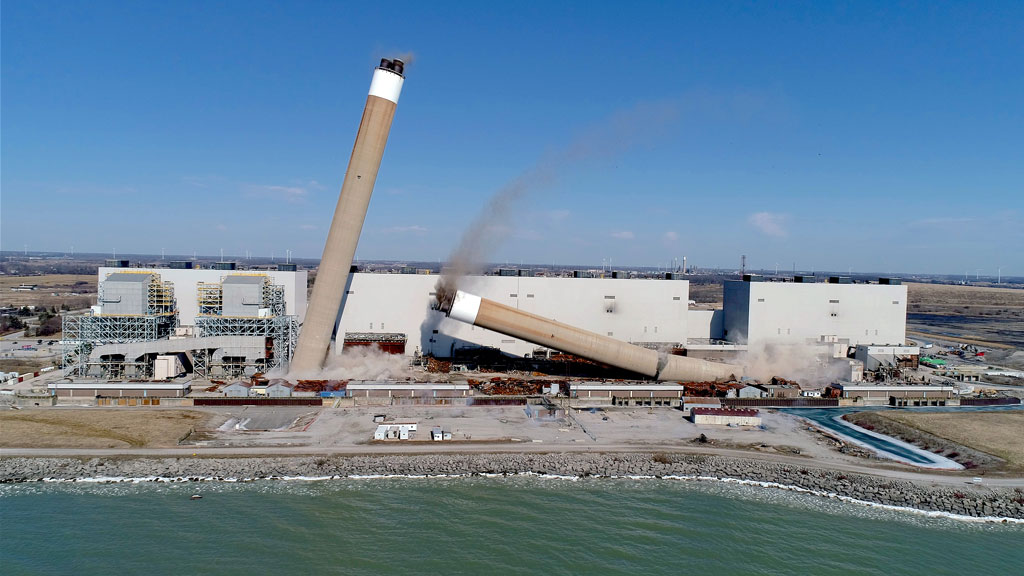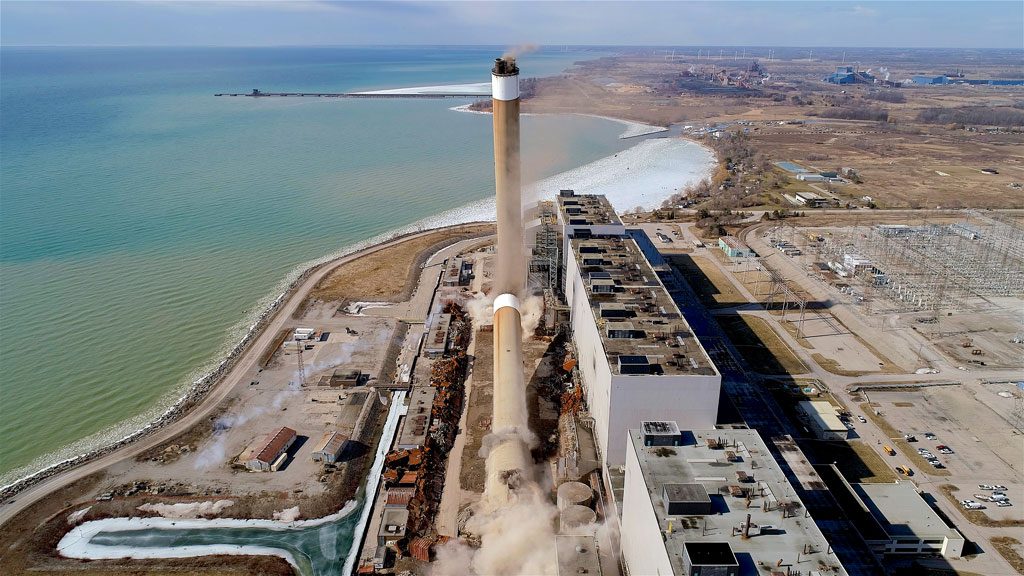What once was the world’s largest coal-fired plant, the Nanticoke Generating Station on the north shore of Lake Erie in Ontario, is now largely a pile of rubble as demolition clears a path for a solar farm.
“You see the future coming in and the past going out,” says Paul Burroughs, a director of project management with Ontario Power Generation (OPG), the plant’s owner.
Burroughs says abatement of asbestos and other hazardous materials is underway and the demolition of the two 198-metre-tall stacks went off without a hitch on Feb. 28.
The stacks were dropped sequentially with 400 to 500 pounds of dynamite each, says Karim El-Khatib, a project director with Delsan-Aim Environmental Services, the contractor responsible for the overall site’s demolition which is slated for completion in early- to mid-2020.
He describes the process as analogous to how a logger falls a tree.
“You make a (pie-cut-like) notch on the side of the stack facing the direction where you want it to fall and you make a horizontal cut on the opposite side of the stack,” he explains. “The explosives blew out the legs/columns that were left behind to support the remainder of the stacks.”
This gave them just enough momentum to fall over, he adds.
For spectators, the demolition was impressive and may have looked straightforward, but the planning and preparation of the drop was extensive.
Safety was paramount, explains Paulo Monteiro, Delsan-Aim’s health and safety manager, who provided a detailed report to the OPG on how the stacks would be dropped to protect surrounding structures, land and the nearby community.
Preparation also included cleaning out the precipitators around the stacks as well as the interiors and flues of any contaminants.

Steel barriers were installed on all sides of the blast drop zone and the wind speed and direction had to be “just right” to prevent the dust cloud from disturbing the surrounding Hydro One operated switch yard facility and the adjacent community, he says.
“It took about four to five months of planning,” says Monteiro. “The blast was only that last two per cent.”
The demolition process was peer-reviewed and the stacks were “dynamically modelled to see how they would behave as they pivot and fall,” says El-Khatib.
Carvajal Structural Engineering Inc. did the modelling and the blasting was done by Rakowski Cartage & Wrecking.
“They had to drop them on the money,” with only one degree of variance on the dropline, he says, noting the stacks “behaved the way the model showed them behaving.”
El-Khatib was also responsible for the demolition of the Four Sisters, the stacks at OPG’s Lakeview Generating Station in Mississauga in 2006. Those stacks had a concrete exterior but the inner flues were comprised of brick. The Nanticoke stacks were made of concrete, the “wind wall” being 27 inches thick, protecting four steel lined flues.
The Nanticoke coal yard and associated infrastructure, including conveyor systems and processing equipment was demolished earlier this year in preparation for construction of a 44-megawatt solar farm, says Burroughs.
A “substantial amount” of the $60 million demolition cost is offset by the resale of equipment and materials from the coal facility which was shut down in 2013, says the OPG director.
Instrumentation and control equipment, machine shop gear, scissor lifts, valves and shelves are among more than 4,500 parts that have found a second life at OPG’s active stations, according to a report by the power generator. Since the decommissioning began in 2015 — prior to Delsan-Aim’s demolition contract — about $3 million worth of parts, tools and equipment have been repurposed.
About 100,000 tonnes of remaining ash will be used for the manufacture of cement products.
Burroughs says it took about a year to work out the details of the overall demolition of the site, which included identifying hazardous materials and abatement procedures, pre-qualifying contractors, the RFP and working with the contractor to plan strategies.
He says the coal plant opened in 1972 and at its peak provided 15 per cent of Ontario’s electricity. When it shut down in 2013, it had produced 4,000 megawatts.
The solar farm going up on the site will cover almost 400 acres and have a production capacity of about one hundredth of the capacity of the coal plant, he says.











Recent Comments